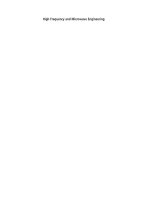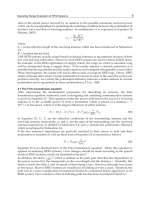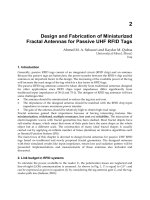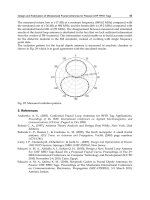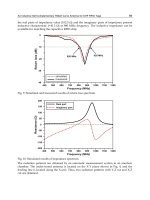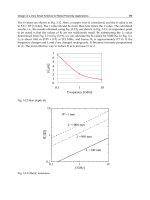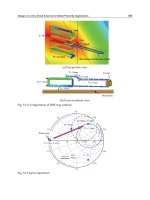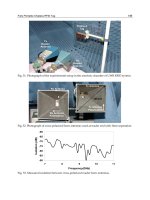radio frequency and microwave communication circuits
Bạn đang xem bản rút gọn của tài liệu. Xem và tải ngay bản đầy đủ của tài liệu tại đây (6.1 MB, 588 trang )
RADIO-FREQUENCY
AND MICROWAVE
COMMUNICATION
CIRCUITS
Radio-Frequency and Microwave Communication Circuits: Analysis and Design
Devendra K. Misra
Copyright # 2001 John Wiley & Sons, Inc.
ISBNs: 0-471-41253-8 (Hardback); 0-471-22435-9 (Electronic)
RADIO-FREQUENCY
AND MICROWAVE
COMMUNICATION
CIRCUITS
ANALYSIS AND DESIGN
DEVENDRA K. MISRA
A WILEY±INTERSCIENCE PUBLICATION
JOHN WILEY & SONS, INC.
New York Chichester Weinheim Brisbane Singapore Toronto
Designations used by companies to distinguish their products are often claimed as trademarks. In all
instances where John Wiley & Sons, Inc., is aware of a claim, the product names appear in initial capital or
ALL CAPITAL LETTERS. Readers, however, should contact the appropriate companies for more complete
information regarding trademarks and registration.
Copyright # 2001 by John Wiley & Sons, Inc. All rights reserved.
No part of this publication may be reproduced, stored in a retrieval system or transmitted in any form
or by any means, electronic or mechanical, including uploading, downloading, printing, decompiling,
recording or otherwise, except as permitted under Sections 107 or 108 of the 1976 United States
Copyright Act, without the prior written permission of the Publisher. Requests to the Publisher for
permission should be addressed to the Permissions Department, John Wiley & Sons, Inc., 605 Third
Avenue, New York, NY 10158-0012, (212) 850-6011, fax (212) 850-6008, E-Mail: PERMREQ@
WILEY.COM.
This publication is designed to provide accurate and authoritative information in regard to the subject
matter covered. It is sold with the understanding that the publisher is not engaged in rendering professional
services. If professional advice or other expert assistance is required, the services of a competent
professional person should be sought.
ISBN 0-471-22435-9
This title is also available in print as ISBN 0-471-41253-8.
For more information about Wiley products, visit our web site at www.Wiley.com.
CONTENTS
Preface ix
Acknowledgements xiii
1. Introduction 1
1.1 Microwave Transmission Lines, 4
2. Communication Systems 9
2.1 Terrestrial Communication, 10
2.2 Satellite Communication, 11
2.3 Radio Frequency Wireless Services, 14
2.4 Antenna Systems, 17
2.5 Noise and Distortion, 34
Suggested Reading, 53
Problems, 53
3. Transmission Lines 57
3.1 Distributed Circuit Analysis of Transmission Lines, 57
3.2 Sending End Impedance, 68
3.3 Standing Wave and Standing Wave Ratio, 81
3.4 Smith Chart, 84
Suggested Reading, 97
Problems, 98
4. Resonant Circuits 105
4.1 Series Resonant Circuits, 105
4.2 Parallel Resonant Circuits, 115
4.3 Transformer-Coupled Circuits, 119
v
4.4 Transmission Line Resonant Circuits, 126
4.5 Microwave Resonators, 134
Suggested Reading, 141
Problems, 142
5. Impedance Matching Networks 146
5.1 Single Reactive Element or Stub Matching, 147
5.2 Double-Stub Matching, 159
5.3 Matching Networks Using Lumped Elements, 164
Suggested Reading, 183
Problems, 183
6. Impedance Transformers 189
6.1 Single-Section Quarter-Wave Transformers, 190
6.2 Multisection Quarter-Wave Transformers, 192
6.3 Transformer with Uniformly Distributed Section Re¯ection
Coef®cients, 195
6.4 Binomial Transformers, 200
6.5 Chebyshev Transformers, 205
6.6 Exact Formulation and Design of Multisection Impedance
Transformers, 212
6.7 Tapered Transmission Lines, 221
6.8 Synthesis of Transmission Line Tapers, 228
6.9 Bode-Fano Constraints for Lossless Matching Networks, 237
Suggested Reading, 240
Problems, 241
7. Two-Port Networks 243
7.1 Impedance Parameters, 244
7.2 Admittance Parameters, 249
7.3 Hybrid Parameters, 256
7.4 Transmission Parameters, 259
7.5 Conversion of the Impedance, Admittance, Chain, and Hybrid
Parameters, 266
7.6 Scattering Parameters, 267
7.7 Conversion From Impedance, Admittance, Chain, and Hybrid
Parameters to Scattering Parameters or Vice Versa, 286
7.8 Chain Scattering Parameters, 287
Suggested Reading, 289
Problems, 289
8. Filter Design 295
8.1 Image Parameter Method, 296
vi CONTENTS
8.2 Insertion Loss Method, 314
8.3 Microwave Filters, 342
Suggested Reading, 352
Problems, 352
9. Signal-Flow Graphs and Applications 354
9.1 De®nitions and Manipulation of Signal-Flow Graphs, 358
9.2 Signal-Flow Graph Representation of a Voltage Source, 363
9.3 Signal-Flow Graph Representation of a Passive Single-Port Device, 364
9.4 Power Gain Equations, 373
Suggested Reading, 381
Problems, 381
10. Transistor Amplifer Design 385
10.1 Stability Considerations, 385
10.2 Ampli®er Design for Maximum Gain, 393
10.3 Constant Gain Circles, 404
10.4 Constant Noise Figure Circles, 424
10.5 Broadband Ampli®ers, 434
10.6 Small-Signal Equivalent Circuit Models of Transistors, 438
10.7 DC Bias Circuits for Transistors, 440
Suggested Reading, 445
Problems, 445
11. Oscillator Design 449
11.1 Feedback and Basic Concepts, 449
11.2 Crystal Oscillators, 460
11.3 Electronic Tuning of Oscillators, 463
11.4 Phase-Locked Loop, 465
11.5 Frequency Synthesizers, 485
11.6 One-Port Negative Resistance Oscillators, 489
11.7 Microwave Transistor Oscillators, 492
Suggested Reading, 508
Problems, 509
12. Detectors and Mixers 513
12.1 Amplitude Modulation, 514
12.2 Frequency Modulation, 525
12.3 Switching-Type Mixers, 531
12.4 Conversion Loss, 537
12.5 Intermodulation Distortion in Diode-Ring Mixers, 539
12.6 FET Mixers, 543
CONTENTS vii
Suggested Reading, 548
Problems, 548
Appendix 1. Decibels and Neper 551
Appendix 2. Characteristics of Selected Transmission Lines 553
Appendix 3. Speci®cations of Selected Coaxial Lines and Waveguides 560
Appendix 4. Some Mathematical Formulas 563
Appendix 5. Properties of Some Materials 566
Appendix 6. Common Abbreviations 567
Appendix 7. Physical Constants 572
Index 573
viii CONTENTS
PREFACE
Wireless technology has been growing tremendously, with new applications reported
almost every day. Besides the traditional applications in communication, such as
radio and television, RF and microwaves are being used in cordless phones, cellular
communication, local area networks (LANs), and personal communication systems
(PCSs). Keyless door entry, radio frequency identi®cation (RFID), monitoring of
patients in a hospital or a nursing home, and cordless mice or keyboards for
computers are some of the other areas where RF technology is being employed.
While some of these applications have traditionally used infrared (IR) technology,
radio frequency circuits are continuously taking over because of their superior
performance. The current rate of growth in RF technology is expected to continue in
the foreseeable future. These advances require personnel trained in radio frequency
and microwave engineering. Therefore, besides regular courses as a part of electrical
engineering curricula, short courses and workshops are regularly conducted in these
areas for practicing engineers. I also introduced a course in this area over ten years
ago to address the needs of local industry. Since the available textbooks generally
assumed that students had more background in electrical circuits and electromag-
netic ®elds than our curriculum provided, I developed the lecture notes for this class.
Based on the input from our alumni, I added a second course as well. This book is
based on the lecture notes that evolved over the past several years.
As mentioned above, the presentation of this book assumes only a basic course in
electronic circuits as a prerequisite. Instead of using electromagnetic ®elds as most
of the microwave engineering books do, the subject is introduced via circuit
concepts. Further, an overview of communication systems is presented in the
beginning to provide the reader with an overall perspective of the various building
blocks involved.
ix
The book is organised into twelve chapters and seven appendices, using a top-
down approach. It begins with an introduction to frequency bands, RF and
microwave devices, and applications in communication, radar, industrial, and
biomedical areas. The introduction also includes a brief description of microwave
transmission linesÐwaveguides, strip lines, and microstrip lines. Modern wireless
communication systems, such as terrestrial and satellite communication systems and
RF wireless services, are brie¯y discussed in Chapter 2. After introducing antenna
terminology, effective isotropic radiated power (EIRP), the Friis transmission
formula, and the radar range equation are presented. The ®nal section of the chapter
introduces noise and distortion associated with communication systems.
Chapter 3 starts with distributed circuits and the construction of solutions to the
transmission line equation. Topics presented in this chapter include RF circuit
analysis, phase and group velocities, sending end impedance, re¯ection coef®cient,
return loss, insertion loss, experimental determination of characteristic impedance
and propagation constant, voltage standing wave ratio (VSWR), and measurement of
impedance. The ®nal section of this chapter includes a description of the Smith chart
and its application in analysis of transmission line circuits.
Resonant circuits are discussed in Chapter 4, which begins with series and
parallel resistance-inductance-capacitance (RLC) circuits. This is followed by a
section on transformer-coupled circuits. The ®nal two sections of this chapter are
devoted to transmission line resonant circuits and microwave resonators. The next
two chapters of the book deal with impedance matching techniques. Single reactive
element or stub, double-stub, and lumped-element matching techniques are
discussed in Chapter 5 while Chapter 6 is devoted to multisection transmission
line impedance transformers. Chapter 6 includes binomial and Chebyshev sections
as well as impedance tapers.
Chapter 7 introduces circuit parameters associated with two-port networks.
Impedance, admittance, hybrid, transmission, scattering, and chain-scattering para-
meters are presented along with examples that illustrate their characteristic beha-
viors. Chapter 8 begins with the image parameter method for the design of passive
®lter circuits. The insertion loss technique is introduced next to synthesize Butter-
worth- and Chebyshev-type low-pass ®lters. It includes impedance and frequency
scaling techniques to realize high-pass, band-pass, and band-stop networks. The
chapter concludes with a section on microwave transmission line ®lter design.
Concepts of signal ¯ow graph analysis are introduced in Chapter 9 along with a
representation of voltage source and passive devices. It facilitates the formulation of
power gain relations that are needed in the ampli®er design discussed in the
following chapter. Chapter 10 starts with stability considerations using scattering
parameters of a two-port network. Design techniques of different ampli®ers are then
presented.
Chapter 11 presents basic concepts and design of various oscillator circuits.
Concepts of the phase-locked loop and its application in the design of frequency
synthesizers are also summarized. The ®nal section of this chapter includes analysis
and design of microwave transistor oscillators using s-parameters. Chapter 12
includes fundamentals of frequency division multiplexing, amplitude modulation,
x
x
PREFACE
radio frequency detection, frequency-modulated signals, and mixer circuits. The
book ends with seven appendices that include a discussion of logarithmic units (dB,
dBm, dBW, dBc, and neper), design equations for selected transmission lines
(coaxial line, strip line, and microstrip line), and a list of abbreviations used in
the communications area.
Some of the highlights of the book are as follows.
The presentation starts with an overview of frequency bands, RF and micro-
wave devices, and their applications in various areas. Communication systems
are presented next in Chapter 2, which motivates students. It includes terrestrial
and satellite systems, wireless services, antenna terminology, the Friis trans-
mission formula, radar equation, and Doppler radar. Thus, students learn about
the systems using blocks of ampli®ers, oscillators, mixers, ®lters, and so on.
Student response here has strongly supported this top-down approach.
Since students are assumed to have had only one semester of electrical circuits,
the resonant circuits and two-port networks are included in this book. Concepts
of network parameters (impedance, admittance, hybrid, transmission, and
scattering) and their characteristics are introduced via examples.
A separate chapter on oscillator design includes concepts of feedback, Hartley
oscillator, Colpitts oscillator, Clapp oscillator, crystal oscillators, PLL and
frequency synthesizers, transistor oscillator design using s-parameters, and 3-
port s-parameter description of transistors and their use in feedback network
design.
There is a separate chapter on the detectors and mixers that includes AM and
FM signal characteristics and their detection schemes, single diode mixers, RF
detectors, double-balanced mixers, conversion loss, intermodulation distortion
in diode ring mixers, and FET mixers.
Appendices include logarithmic units, design equations for selected transmis-
sion lines, and a list of abbreviations used in the communication area.
There are over 130 solved examples with step-by-step explanations. Practicing
engineers will ®nd this text useful for self-study as well.
There are nearly 200 class-tested problems. Supplementary material is avail-
able to instructors adopting the book. This includes an instructor's manual and
access to a web page containing useful material, such as downloadable ®les
used for solving the problems, reference material, and URLs of other useful
sites.
PREFACE xi
ACKNOWLEDGMENTS
I learned this subject from engineers and authors who are too many to include in this
short space. I would like to gratefully acknowledge their contributions. I would like
to thank my anonymous reviewers, and my former students, who made several
constructive suggestions to improve the presentation. I deeply appreciate the support
I received from my wife Ila and son Shashank during the course of this project. This
book became a reality only because of the enthusiastic support I received from
Senior Editor Dr. Philip Meyler and his staff at John Wiley & Sons.
D
EVENDRA K. MISRA
xiii
INDEX
Active ®lters, 295
Admittance matrix, 250
Admittance parameters, 249
Advanced Mobile Phone Service, 14
Ampli®er design for maximum gain
bilateral case, 396
unilateral case, 394
Amplitude modulation, 514
coherent detection, 524
DSB, 516
modulation index, 514
SSB, 516, 524
Antenna
aperture-type, 17
bandwidth, 22
directive gain, 17
directivity, 17
ef®ciency, 21
electric dipole, 17
gain, 19
hog-horn, 11
horn, 18
HPBW, 19
isotropic, 17
lens, 18
loop, 17
parabolic, 11
polarization, 22
polarization loss, 23
primary, 17
radiation pattern, 19
re¯ector, 18
secondary, 17
tepered horn, 11
wire, 17
Available power gain, 377
Balanced ampli®er, 436
Band-pass ®lter, 334
Band-stop ®lter, 338
BARITT, 6
Barkhausen criterion, 450
Binomial ®lter. See maximally ¯at ®lter
Bode-Fano constraints, 237
Bode-Fano criteria, 240
Broadband ampli®ers
balanced circuits, 436
compensating networks, 434
negative feedback, 435
resistive matching, 434
traveling wave ampli®ers, 437
Butterworth ®lter. See maximally ¯at ®lter
Cellular telephones, 15
Ceramic crystals, 460
Chain matrix, 259
Chain scattering parameters, 287
Characteristic impedance
experimental determination of, 77
Chebyshev ®lter, 318
Chebyshev polynomials, 206±207, 318
Circles of instability, 389
Circular cylindrical cavity, 136
Clapp oscillator, 456
Coaxial line, 553
Coef®cient of coupling, 121
Colpitts oscillator, 454, 460
Commensurate lines, 347
Composite ®lters
design relations, 310
Composite ®lters, 308
Conductivity, 59
573
Radio-Frequency and Microwave Communication Circuits: Analysis and Design
Devendra K. Misra
Copyright # 2001 John Wiley & Sons, Inc.
ISBNs: 0-471-41253-8 (Hardback); 0-471-22435-9 (Electronic)
Constant gain circles
bilateral case, 413±415
unilateral case, 404±406
Constant noise ®gure circles, 425
Constant-k Filter sections, 299
Conversion between scattering and chain
scattering parameters, 289
Conversion from (to) impedance,
admittance, chain, or hybrid to (from)
scattering parameters, 288
Conversion transconductance, 545
Conversions among the impedance,
admittance, chain, and hybrid
parameters, 267
Cordless telephones, 16
Critically damped, 107
Current re¯ection coef®cient, 74
Current sensitivity, 522
Cutoff frequency, 299
Damping ratio, 107
dBc, 552
dBm, 552
dBW, 552
DC bias circuits, 440±445
Decibels, 551
Dielectric resonators, 138
Diode
Gunn, 489
IMPATT, 6, 489
Schottky, 10
varacter, 11, 463
Direct digital synthesis, 485
Direct-to-home, 14
Distortionless line, 76
Distributed ampli®ers. See Traveling wave
ampli®ers
Distributed elements, 57
Doppler radar, 32
Double-balanced mixer, 534
Double-stub matching, 159
Down converter, 518
Dual-gate FET mixer, 547
Dynamic conductance, 520
Dynamic range, 49, 52
Effective area, 20
EIRP, 24
Exponential taper, 222
FET balanced mixer, 547
FET mixer, 543
Filter design
frequency scaling, 324
impedance scaling, 324
Filter transformations, 341
FM detector, 529
Fourier transform, 228
Frequency band
commercial broadcast, 2
IEEE, 2
microwave, 3
Frequency converters, 517
Frequency deviation coef®cient, 526
Frequency divider, 486
Frequency division multiplexing, 513
Frequency modulation
Carson rule bandwidth, 527
frequency deviation coef®cient, 526
modulation index, 526
narrowband FM, 528
wideband FM, 528
Frequency modulation, 513, 525
Frequency scaling, 324
Frequency synthesizer, 485
Friis transmission formula, 26
Gain compression, 49
Global positioning system, 14
Group velocity, 65
Gunn diode, 489
Hartley oscillator, 454, 460
HBT, 385
Helmholtz equations, 63
HEMT, 385
High-de®nition television, 13
High-Pass ®lter, 332
Hybrid parameters, 256
Hyperthermia, 4,7
Image impedance, 296, 299
Imaging, 4, 7
IMPATT, 6, 489
Impedance
measurement of, 85
Impedance matrix, 244
Impedance parameters, 244
Impedance scaling, 324
Impedance transformer
multi-section, exact theory, 212
574
INDEX
Incident wave, 64
Indirect synthesis, 485
Input re¯ection coef®cient, 69
Insertion loss, 74, 295
Insertion-loss method, 296, 314
Integrator and lead ®lter, 469
Integrator and lead-lag ®lter, 472
Intercept point, 51
Intermodulation distortion, 46
Intermodulation distortion ratio, 50, 52
Inverse Laplace transform, 108
Ionosphere, 3
IR, 2
Klopfenstein taper, 235
Klystrons, 6
Kuroda's identities, 348±350
LAN, 2
Laplace transform, 106
Lead-lag ®lter, 469
Load impedance circle, 390
Load re¯ection coef®cient, 73
Loop-®lters, 468±475
Loss-tangent, 59
Low-pass ®lter, 316
Low-pass ®lter synthesis, 321
Magnetron, 6
MAN, 2
Mason's rule, 361
Maximally ¯at ®lter, 316
Maximum stable gain, 400
m-derived section, 303
Microstrip line, 556
Microwave drying, 7
Microwave ®lter, 342
Microwave transistor oscillator circuit, 493
Microwave transmission lines
circular waveguides, 7
®ne line, 7
microstrip line, 7, 556
rectangular waveguides, 7
ridged waveguides, 7
semirigid coaxial lines, 4
slot line, 7
strip line, 7, 554
Minimum detectable signal, 45
Minkowski inequality, 387
Mixers
conversion loss, 537
intermodulation distortion, 541
MPEG, 13
Multisection binomial transformers, 200
Mutual inductance, 120
Negative resistance, 458
Neper, 552
Noise
1/f. See ¯icker
¯icker, 34
pink. See ¯icker
shot, 34
thermal, 34, 35
Noise factor, 38
Noise ®gure, 39
Noise ®gure of cascaded systems, 42
Noise ®gure parameter, 425
Noise temperature, 36
Noisy two-port network, 40
Normalized frequency, 306
Normalized image impedance, 306
Normalized input impedance, 69
Notch-®lter, 295
Nyquist criterion, 450
Open-circuited line, 129
Operating power gain, 376
Optimum source admittance, 424
Optimum source re¯ection coef®cient, 424
Overdamped, 107
Parallel R-L-C circuit
input admittance, 117
input impedance, 117, 119
Passive ®lters, 295
PCS, 2
Phase detector, 466
Phase locked loop terminology
acquisition of lock, 478
hold-in range, 476
lock range. See hold-in range
lock-in range, 478
pull-in range, 479
synchronization range. See hold-in range
tracking range. See hold-in range
Phase velocity, 65
Phase-locked loop, 465
Pierce oscillator, 462
PLL components, 476
Power loss ratio, 212, 315
INDEX 575
Propagation constant
experimental determination of, 77
Pulling ®gure, 462
Q. See Quality factor
Quality factor, 109, 113
Quality factor of a resonant circuit
external Q, 118
loaded Q, 119
unloaded Q, 117
Quarter-wave transformer
binomial, 200
Chebyshev, 205
multi-section, 192
single-section, 190
uniformly distributed, 195
Quartz, 460
Radar
applications, 7
Radar cross-section, 29
Radar equation, 29
Radiation intensity, 18
Radio frequency wireless services, 14
Radio-frequency detector, 521
Reactive L-section matching, 166
Rectangular cavity, 134
Redundant ®lter synthesis, 342
Re¯ected wave, 64
Re¯ection coef®cient, 73
Relations for series and parallel resonant
circuits, 119
Repeater system, 10
Resistive L-section matching, 164
Resonant frequency, 112, 116
Resonant lines
equivalent circuit parameters, 130
Return-loss, 74
RFID, 2
Richard's transformation, 347
Sampling theorem, 230
Satellite
geo-stationary. See geo-synchronous
geo-synchronous, 11
LEOS, 13
MEOS, 13
personal communication, 14
transponder, 11
Satellite communication, 4, 11
Scattering matrix, 268
Scattering parameters, 267
Scattering transfer parameters, 287
Second harmonic distortion, 50
Series R-L-C circuit, 105
input impedance, 114, 119
Series stub, 148
Short-circuited line, 127
Shunt stub, 147
Signal ¯ow graph
branches, 354
input node, 358
junction points, 354
loop, 359
Mason's rule, 361
nodes, 354
of a passive single-port, 364
of a two-port network, 367
of a voltage source, 363
output node, 358
path, 359
rules of reduction, 360
sink, 358
source, 358
Signal-¯ow graph of a one-port passive
device, 366
Simultaneous Conjugate Matching, 396
Single balanced mixer, 531
Single-diode mixer, 518
Sky wave, 5
Small-signal equivalent circuit model
for BJT, 438
Small-signal equivalent circuit of a
MESFET, 440
Small-signal equivalent circuit of a
MOSFET, 439
Smith chart, 87
Source stability circle, 391
Space loss, 25
SSB generation, 524
Stability circle, 389±391
Standing wave, 83
Stepped impedance ®lter, 342
Strip Line, 554
TED, 6
Telemetry, 4
Terrestrial communication, 10
Terrestrial communication system, 4
Three-port S-parameter description of the
transistor, 500
Three-section impedance transformer
exact theory, 217
Time-period, 65
Transducer power gain, 374
576
INDEX
Transformer-coupled circuit, 119
Transmission line
attenuation constant, 63
characteristic impedance, 59
distributed network model, 61
line parameters, 58
phase constant, 63
propagation constant, 63
tapers, 221
Transmission line resonant circuits, 126
Transmission line taper
synthesis, 228
Transmission matrix. See chain matrix
Transmission parameters, 259
TRAPATT, 6
Traveling wave ampli®ers, 437
Troposphere, 3
Tuning sensitivity, 465
Two-section impedance transformer
exact theory, 213
TWT, 13
Undamped natural frequency, 107
Underdamped, 107
Unilateral ®gure of merit, 402
Unilateral transducer power gain, 376
Up-converter, 518
Varactor, 11, 463
Very small aperture terminal. See VSAT
Voltage controlled oscillator, 467±468
Voltage re¯ection coef®cient, 73
Voltage sensitivity, 522
VSAT, 13
VSWR, 84
VSWR circle, 150, 152
WA N, 2
Wavelength, 65
Y-Smith chart, 178
Z-Smith chart, 177
ZY-Smith chart, 179
INDEX 577
1
INTRODUCTION
Scientists and mathematicians of the nineteenth century laid the foundation of
telecommunication and wireless technology, which has affected all facets of modern
society. In 1864, James C. Maxwell put forth fundamental relations of electro-
magnetic ®elds that not only summed up the research ®ndings of Laplace, Poisson,
Faraday, Gauss, and others but also predicted the propagation of electrical signals
through space. Heinrich Hertz subsequently veri®ed this in 1887 and Guglielmo
Marconi successfully transmitted wireless signals across the Atlantic Ocean in 1900.
Interested readers may ®nd an excellent reference on the historical developments of
radio frequencies (RF) and microwaves in the IEEE Transactions on Microwave
Theory and Technique (Vol. MTT-32, September 1984).
Wireless communication systems require high-frequency signals for the ef®cient
transmission of information. There are several factors that lead to this requirement.
For example, an antenna radiates ef®ciently if its size is comparable to the signal
wavelength. Since the signal frequency is inversely related to its wavelength,
antennas operating at radio frequencies and microwaves have higher radiation
ef®ciencies. Further, their size is relatively small and hence convenient for mobile
communication. Another factor to favor RF and microwaves is that the transmission
of broadband information signals requires a high-frequency carrier signal. In the
case of a single audio channel, the information bandwidth is about 20 kHz. If
amplitude modulation is used to superimpose this information on a carrier then it
requires at least this much bandwidth on one side of the spectrum. Further,
commercial AM transmission requires a separation of 10 kHz between the two
transmitters. On the other hand, the required bandwidth increases signi®cantly if
frequency modulation is used. Each FM transmitter typically needs a bandwidth of
200 kHz for audio transmission. Similarly, each television channel requires about
1
Radio-Frequency and Microwave Communication Circuits: Analysis and Design
Devendra K. Misra
Copyright # 2001 John Wiley & Sons, Inc.
ISBNs: 0-471-41253-8 (Hardback); 0-471-22435-9 (Electronic)
6 MHz bandwidth to carry the video information as well. Table 1.1 shows the
frequency bands used for commercial radio and television broadcasts.
In the case of digital transmission, a standard monochrome television picture is
sampled over a grid of 512 Â480 elements that are called pixels. Eight bits are
required to represent 256 shades of the gray display. In order to display motion,
30 frames are sampled per second. Thus, it requires about 59 Mb=s
(512 Â 480 Â 8 Â30 58;982;400). Color transmission requires even higher band-
width (on the order of 90 Mb=s).
Wireless technology has been expanding very fast, with new applications
reported every day. Besides the traditional applications in communication, such as
radio and television, RF and microwave signals are being used in cordless phones,
cellular communication, LAN, WAN, MAN, and PCS. Keyless door entry, radio-
frequency identi®cation (RFID), monitoring of patients in a hospital or a nursing
home, and cordless mice or keyboards for computers are some of the other areas
where RF technology is being applied. While some of these applications have
traditionally used infrared (IR) technology, current trends are moving toward RF. The
fact is that RF is superior to infrared technology in many ways. Unlike RF, infrared
technology requires unobstructed line-of-sight connection. Although RF devices are
more expensive in comparison with IR, this is expected to change soon as their
production and use increases.
TABLE 1.1 Frequency Bands Used in Commercial Broadcasting
Channels Frequency Range Wavelength Range
AM 107 535 kHz±1605 kHz 186.92 m±560.75 m
TV 2±4 54 MHz±72 MHz 4.17 m±5.56 m
5±6 76 MHz±88 MHz 3.41 m±3.95 m
FM 100 88 MHz±108 MHz 2.78 m±3.41 m
TV 7±13 174MHz±216 MHz 1.39 m±1.72 m
14±83 470 MHz±890 MHz 33.7 cm±63.83 cm
TABLE 1.2 IEEE Frequency Band Designations
Band Designation Frequency Range
Wavelength Range
(in free-space)
VLF 3±30 kHz 10 km±100 km
LF 30±300 kHz 1 km±10 km
MF 300±3000 kHz 100 m±1 km
HF 3±30 MHz 10 m±100 m
VHF 30±300 MHz 1 m±10 m
UHF 300±3000 MHz 10 cm±1 m
SHF 3±30 GHz 1 cm±10 cm
EHF 30±300 GHz 0.1 cm±1 cm
2
INTRODUCTION
The electromagnetic frequency spectrum is divided into bands as shown in Table
1.2. Hence, AM radio transmission operates in the medium frequency (MF) band;
television channels 2±12 operate in the very high frequency (VHF) band; and
channels 18±90 operate in ultra high frequency (UHF) band. Table 1.3 shows the
band designations in the microwave frequency range.
TABLE 1.3 Microwave Frequency Band Designations
Frequency Bands
Old
(still widely used)
New
(not so commonly used)
500±1000 MHz UHF C
1±2 GHz L D
2±4 GHz S E
3±4 GHz S F
4±6 GHz C G
6±8 GHz C H
8±10 GHz X I
10±12.4 GHz X J
12.4±18 GHz Ku J
18±20 GHz K J
20±26.5 GHz K K
26.5±40 GHz Ka K
Figure 1.1 Atmosphere surrounding the earth.
INTRODUCTION 3
Besides the natural and human-made changes, electrical characteristics of the
atmosphere affect the propagation of electrical signals. Figure 1.1 shows various
layers of the ionosphere and the troposphere that are formed due to the ionization of
atmospheric air. As illustrated in Figure 1.2(a) and (b), a radio frequency signal can
reach the receiver by propagating along the ground or after re¯ection from the
ionosphere. These signals may be classi®ed as ground and sky waves, respectively.
Behavior of the sky wave depends on the season, day or night, and solar radiation.
The ionosphere does not re¯ect microwaves and the signals propagate line-of-sight,
as shown in Figure 1.2(c). Hence, curvature of the earth limits the range of a
microwave communication link to less than 50 km. One way to increase the range is
to place a human-made re¯ector up in the sky. This kind of arrangement is called the
satellite communication system. Another way to increase the range of a microwave
link is to place the repeaters at periodic intervals. This is known as the terrestrial
communication system.
Figures 1.3 and 1.4 list selected devices used at RF and microwave frequencies.
Solid-state devices as well as vacuum tubes are used as active elements in RF and
microwave circuits. Predominant applications for microwave tubes are in radar,
communications, electronic countermeasures (ECM), and microwave cooking. They
are also used in particle accelerators, plasma heating, material processing, and power
transmission. Solid-state devices are employed mainly in the RF region and in low-
power microwave circuits, such as low-power transmitters for LAN, and receiver
circuits. Some of the applications of solid-state devices are listed in Table 1.4.
Figure 1.5 lists some applications of microwaves. Besides terrestrial and satellite
communications, microwaves are used in radar systems as well as in various
industrial and medical applications. Civilian applications of radar include air-traf®c
control, navigation, remote sensing, and law enforcement. Its military uses include
surveillance, guidance of weapons, and C
3
(command, control, and communication).
Radio frequency and microwave energy is also used in industrial heating as well as
household cooking. Since this process does not use a conduction mechanism for the
heat transfer, it can improve the quality of certain products signi®cantly. For
example, the hot air used in a printing press to dry the ink adversely affects the
paper and shortens its life span. On the other hand, only the ink portion is heated in
microwave drying and the paper is barely affected by it. Microwaves are also used in
material processing, telemetry, imaging, and hyperthermia.
1.1 MICROWAVE TRANSMISSION LINES
Figure 1.6 shows selected transmission lines used in RF and microwave circuits. The
most common transmission line used in the RF and microwave range is the coaxial
line. A low-loss dielectric material is used in these transmission lines to minimize the
signal loss. Semirigid coaxial lines with continuous cylindrical conductors outside
perform well in microwave range. In order to ensure single-mode transmission, the
cross-section of a coaxial line must be much smaller in comparison with the signal
wavelength. However, this limits the power capacity of these lines. In high-power
4 INTRODUCTION
Figure 1.2 Modes of signal propagation.
MICROWAVE TRANSMISSION LINES 5
TABLE 1.4 Selected Applications of Microwave Solid-State Devices
Devices Applications Advantages
Transistors L-band transmitters for telemetry
systems and phased-array radar
systems; transmitters for
communication systems
Low cost, low power supply,
reliable, high CW power output,
lightweight
TED C, X, and Ku-band ECM ampli®ers
for wideband systems; X and
Ku-band transmitters for radar
systems, such as traf®c control
Low power supply (12 V), low
cost, lightweight, reliable, low
noise, high gain
IMPATT Transmitters for mm-wave
communication
Low power supply, low cost,
reliable, high CW power,
lightweight
TRAPATT S-band pulsed transmitter for
phased-array radar systems
High peak and average power,
reliable, low power supply, low
cost
BARITT Local oscillators in communication
and radar receivers
Low power supply, low cost, low
noise, reliable
Figure 1.3 Microwave devices.
Figure 1.4 Solid-state devices used at RF and microwave frequencies.
6
INTRODUCTION
Figure 1.5 Some applications of microwaves.
Figure 1.6 Transmission lines used in RF and microwave circuits.
MICROWAVE TRANSMISSION LINES 7
microwave circuits, waveguides are used in place of coaxial lines. Rectangular
waveguides are commonly employed for connecting the high-power microwave
devices because these are easy to manufacture in comparison with circular
waveguides. However, certain devices (such as rotary joints) require a circular
cross-section. The ridged waveguide provides broadband operation in comparison
with the rectangular one. The ®n line shown in Figure 1.6 (e) is commonly used in
the mm-wave band. Physically, it resembles a combination of slot line enclosed in a
rectangular waveguide.
The transmission lines illustrated in Figure 1.6 (f)±(h) are most convenient in
connecting the circuit components on a printed circuit board (PCB). The
physical dimensions of these transmission lines are dependent on the dielectric
constant e
r
of insulating material and on the operating frequency band. The
characteristics and design formulas of selected transmission lines are given in the
appendices. Chapter 2 provides an overview of wireless communication systems and
their characteristics.
8 INTRODUCTION
2
COMMUNICATION SYSTEMS
Modern communication systems require radio frequency and microwave signals for
the wireless transmission of information. These systems employ oscillators, mixers,
®lters, and ampli®ers to generate and process various kinds of signals. The
transmitter communicates with the receiver via antennas placed on each side.
Electrical noise associated with the systems and the channel affects the performance.
A system designer needs to know about the channel characteristics and system noise
in order to estimate the required power levels. This chapter begins with an overview
of microwave communication systems and the radio frequency wireless services to
illustrate the applications of circuits and devices that are described in the following
chapters. It also gives an idea to the reader about the placement of different building
blocks in a given system.
A short discussion on antennas is included to help in understanding the signal
behavior when it propagates from transmitter to receiver. The Friis transmission
formula and the radar range equation are important in order to understand effects of
frequency, range, and operating power levels on the performance of a communica-
tion system. Note that radar concepts now ®nd many other applications, such as
proximity or level sensing in an industrial environment. Therefore, a brief discussion
on Doppler radar is also included in this chapter. Noise and distortion characteristics
play a signi®cant role in analysis and design of these systems. Minimum detectable
signal (MDS), gain compression, intercept-point, and the dynamic range of an
ampli®er (or the receiver) are subsequently introduced. Other concepts associated
with noise and distortion characteristics are also introduced in this chapter.
9
Radio-Frequency and Microwave Communication Circuits: Analysis and Design
Devendra K. Misra
Copyright # 2001 John Wiley & Sons, Inc.
ISBNs: 0-471-41253-8 (Hardback); 0-471-22435-9 (Electronic)

